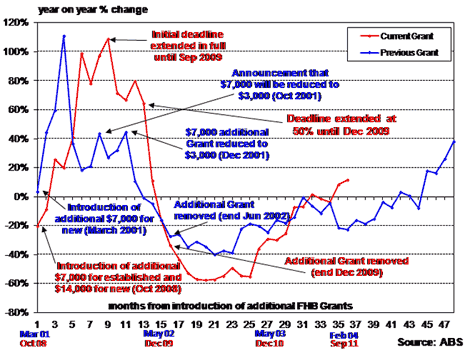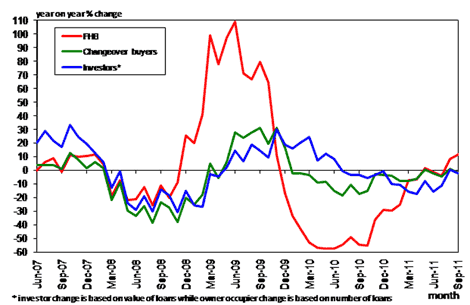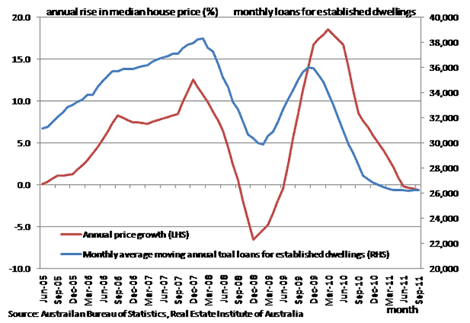First-home buyers to drive 2012 housing price recovery: BIS Shrapnel's Angie Zigomanis
First-home buyers represent a key driver of the residential market, underpinning demand for entry-level dwellings, which in turn creates increased demand across the market. While first-home buyers have averaged only 16% of finance for residential property over the last 20 years, they have a disproportionate impact on turnover activity and consequently prices.
While the focus on the reasons for the decline in first-home buyer demand in the media has been on the impact of the rises in interest rates over 2009-10 on affordability, the majority of the decline has been due to the demand brought forward by the First Home Owner’s Grant Boost Scheme. Total loans to first-home buyers have averaged around 130,000 per annum over the last five years. However, loans to first-home buyers rose to 190,000 in calendar 2009 during the operation of the boost.
As the pool of potential first-home buyers is finite at around the 130,000 per annum level, it means that a future demand of around 60,000 first-home buyers had been brought forward to take advantage of the boost. With about 90,000 to 95,000 loans to first-home buyers expected over each of 2010 and 2011, this “pull forward” effect has now largely been exhausted, and demand from first home buyers should slowly return back to underlying average levels.
This is highlighted in Chart I, which shows a comparison of year-on-year growth in loans to first home buyers after the original First Home Owner’s Grant Scheme was increased from $7,000 to $14,000 in March 2001, compared with lending after the First Home Owner’s Grant Boost Scheme was introduced in October 2008. From a timing perspective the grants were in place for a similar period, being in place for around 16 and 15 months respectively.
Click to enlargeInterestingly, the trend in first-home buyer activity has been almost identical when comparing the recent boost scheme with the initial first-home owner’s grant. Substantial first-home buyer activity was brought forward to take advantage of the grants while they were in place. This created a subsequent “hole” in first-home buyer demand over the following two year period.
As indicated by the red line reflecting the impact of the most recent boost, first-home buyer activity is now showing year-on-year growth – despite the weaker overall economic conditions in 2011 compared with 2010. In comparison, at a similar point in time after the original first-home owner’s grant (February 2004), there was a setback in first-home buyer demand. However, conditions were different. Where interest rates are now declining, the market in February 2004 had experienced a 25-basis-point rise in interest rates in each of November and December 2003. As a result, there was a pause in first-home buyer demand for about six months before growth in activity again resumed (the next rise in interest rates was to be in March 2005. Consequently, with a benign interest rate environment anticipated over 2012, we anticipate that first-home buyer demand will continue to recover, and by the end of 2012 monthly first-home buyer demand should be reflecting the underlying level of around 130,000 loans per annum.
Healthy first-home buyer demand is important from a turnover and price perspective. Without demand for entry level properties, the impetus for demand from changeover buyers (i.e. upgraders and downsizers) is reduced as they usually have the option of staying in their existing dwelling and sitting out of the market when demand is weak. Similarly, investors can also sit out of the market when conditions aren’t conducive.
Most first-home buyers, on the other hand, are not able to postpone a purchase indefinitely. They will ultimately reach a life stage where they move into the market as purchasers. Those who can’t purchase their desired dwelling at the time will make a trade off by purchasing a smaller dwelling in their desired location, or purchasing in a more affordable location.
Consequently, it is often the movement in first-home buyer demand that creates the flow-on effects in demand across the rest of the market. This is highlighted in chart II. The increase in first-home buyer demand created by the boost scheme resulted in a subsequent rise in changeover activity. Given the much larger number of changeover buyers in the market, the percentage increase in changeover activity was lower, although still substantial – as highlighted by a comparison with the growth in changeover buyers that occurred in 2007 before the beginning of the GFC. Conversely, the fall-off in first-home buyer demand after the boost scheme expired has also resulted in a fall-off in changeover activity that is now stabilising as first-home buyer demand improves.Click to enlarge
Investor demand also coincided with the rise in first-home buyer demand over 2009. However, investor demand is not dependent on owner-occupier demand, with investors able to make purchases at their discretion. While investment fundamentals such as rental growth and yields will also influence investor demand, the prospect for capital growth is by far the key driver of investor demand. It was the rise in prices in 2009 and early 2010 that underpinned the rise in investor demand, and in an environment where prices have been declining over 2011, investor demand has been weakening.
As a result, the recovery in first home buyer demand will have a positive impact on price growth. As highlighted in chart III, there is a strong correlation between turnover activity (as indicated in the table by owner occupier lending for established dwellings) and median house price growth. Periods of rising turnover have corresponded with rising price growth, while weaker activity results in weaker price performance. In recent months, the tapering off in the decline in turnover activity has corresponded with a slowing in the rate of decline in median house prices.
Click to enlargeConsequently, in contrast to current concerns about price falls continuing, BIS Shrapnel’s view is that the recovery in first home buyer demand will facilitate the recovery in the housing market. Prices have now either bottomed out or should bottom out in the next few months and – barring any major shock on the overseas front – we will see the rising volume of activity will translate to a return of price growth 2012. Turnover will return to growth through 2012 as the recovery in first-home buyer demand gains momentum (although it could take a little longer in New South Wales given its recent changes to first-home buyer stamp duty exemptions) and flows through to changeover demand and increased activity across the market. The turnaround in price expectations will also drive stronger investor demand through 2012, which in turn will facilitate greater turnover.
As first-home buyer demand returns to underlying levels by the end of the year, price growth will strengthen and pick up further in 2013, particularly with our expectation of an improved economic outlook. The increased activity for existing dwellings will also allow upgraders to trade up into new houses and drive a recovery in new house commencements. Nevertheless, despite the expectation of a recovery in the market, the prospects for substantial rises in prices will be constrained by current strained affordability. In those markets in oversupply or close to balance, it means that the current price declines will halt, with only minimal growth coming through, while in those markets where there is a rising deficiency, price growth is expected to be stronger, although still only moderate (mid-single-digit growth per annum).
Angie Zigomanis is senior manager of BIS Shrapnel.


